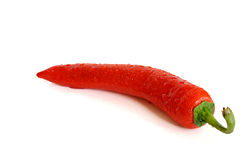Chillies
These days, we all know about chilli peppers. We have them on pizzas, in sauces, and even on patios simply as decorative plants. Although very abundant in hotter countries, chillies really only began to appear in Irish supermarkets within the last 15 years or so.
Growing chillies
Germination
The most effective method for germinating chilli seeds in Ireland is the wet paper towel method. Do this in mid-Spring so that they begin to grow in time for the rest of the season.
- Fold up a few layers of kitchen towel and wet it under a tap. Wring it out so it's not too wet.
- Open the towel up like a book, and on one half lay out the chilli seeds in rows, ~2cm away from each other.
- Fold over the other half, so that the seeds are enclosed in damp paper towel.
- Put the seeds and towel into a ziplock sandwich bag, and put into a hotpress.
- After 10-14 days, the seeds will have grown a taproot big enough for transplanting into a propagator.
Growing
You need to keep chilli plants in warm environment to promote growth. This can be a greenhouse or a south-facing window. In around early April, transplant the seedlings into a propagator or a pot covered in clingfilm. The compost should not be too wet. When the plants grow their second set of leaves you can take them out of the propagator (or remove the clingfilm) and let them continue to grow in the greenhouse or window.
Chillies like to be treated mean: don't overwater and don't use any plantfood. This will allow the heat to build up much better.
If there are a lot of leaves on the plant and very few chillies, snip off a few leaves. This will allow the nutrients in the plant to go towards growing the chillies.
Harvesting
This is best done in late summer/early autumn. The chillies can be red or green when harvested, it's entirely up to you (and up to whatever the plant produces!). They can be used fresh, dried, or frozen.
Chilli peppers for culinary use
Drying chillies
The traditional way to dry chillies is to hang them in a sunlit window. In Irish weather, this is best done during the summer, and only peppers with undamaged stalks should be used (broken ones let in moisture and bacteria and will cause the chilli to rot).
- Tie 2 or 3 fresh chilli peppers together by their stalks using string or an elastic band.
- Hang the bundle on a hook at a south-facing window.
- In 4-6 weeks the chillies should be dry enough to grind up (if they're not, chop them up and let them dry in the open for a couple of days).
- If you shake the chilli, you will hear a rattling if it is dry enough. The noise is made by the seeds, which can be saved and used to grow more plants.
The dried flakes can be sprinkled into dishes during cooking, or, if you like a bit of extra heat, used as a seasoning for a served dish.
Fresh chillies
When preparing fresh chillies, please note that the capsaicin in the peppers is an irritant. If you have sensitive skin, wear rubber gloves. If you decide not to wear gloves, be sure to wash your hands thoroughly, as the oil from the chilli is difficult to remove. If you touch your eyes, nose, or any other sensitive part of the body without taking the proper precautions you will feel the effects for a couple of hours. And it's not nice!
To prepare a fresh chilli:
- With a small sharp knife, split the chilli pepper along its length into two halves.
- Put each half on a chopping board, open side up. With the knife, scrape along the inside of the chilli to remove the seeds.
- Chop the chilli halves as required for cooking.
Most people tend to remove the seeds, but if you wish, you can leave them in, and simply slice up the whole chilli.
